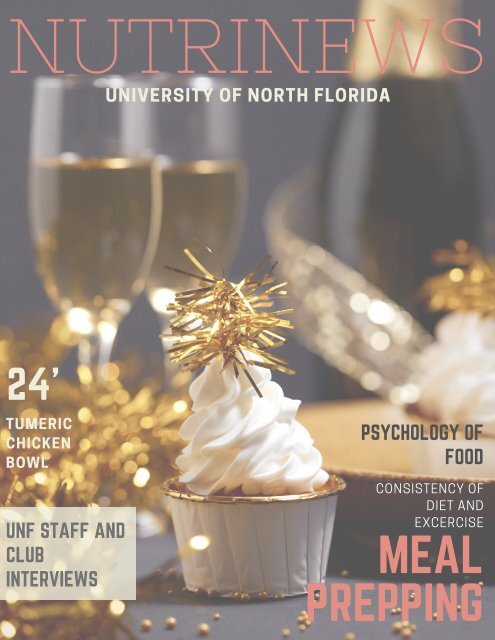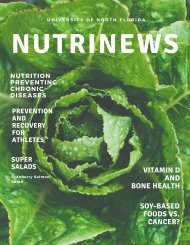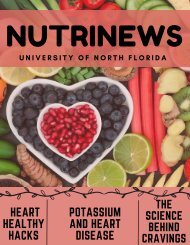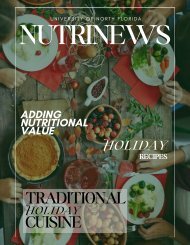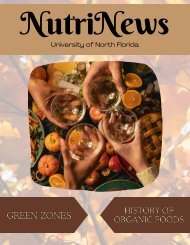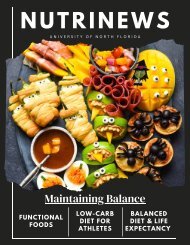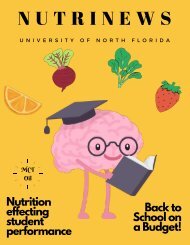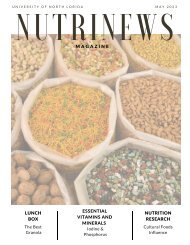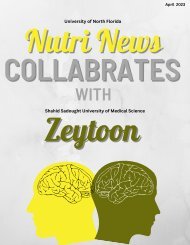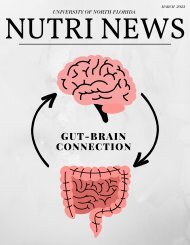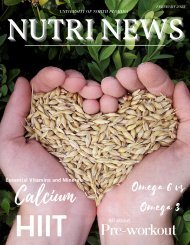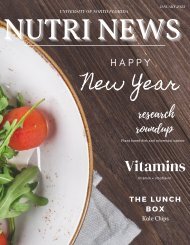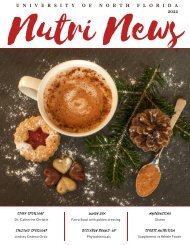January 2024
As the new year begins, many are implementing resolutions. Therefore, this months issue focuses on nutrition resolutions. Creating resolutions that are reachable, attainable, and measurable is extremely important for consistency and lasting lifestyle changes.
As the new year begins, many are implementing resolutions. Therefore, this months issue focuses on nutrition resolutions. Creating resolutions that are reachable, attainable, and measurable is extremely important for consistency and lasting lifestyle changes.
Create successful ePaper yourself
Turn your PDF publications into a flip-book with our unique Google optimized e-Paper software.
NUTRINEWS<br />
UNIVERSITY OF NORTH FLORIDA<br />
24'<br />
TUMERIC<br />
CHICKEN<br />
BOWL<br />
UNF STAFF AND<br />
CLUB<br />
INTERVIEWS<br />
PSYCHOLOGY OF<br />
FOOD<br />
CONSISTENCY OF<br />
DIET AND<br />
EXCERCISE<br />
MEAL<br />
PREPPING
Table of Contents<br />
“Every time you tear a leaf off a calendar, you present a new place for new ideas.” .”<br />
-Charles Kettering, Engineer<br />
and Businessman<br />
SPORTS NUTRITION<br />
Importance of Consistency with Diet and Exercise<br />
STUDENT/SATFF SPOTLIGHT<br />
Staff Interview with Claudia Rivero<br />
04<br />
08<br />
LUNCH BOX<br />
Tumeric Turkey Bowl and Strawberry Chicken Salad 11<br />
MYTH BUSTING<br />
Should Carbohydrates Be Avoided?<br />
COMMUNITY/CLUB SPOTLIGHT<br />
Get to Know Our UNF Swim Club<br />
12<br />
15<br />
NUTRITION RESEARCH<br />
Psychology of Food 16<br />
VITAMINS AND MINERALS<br />
Vitamin and Mineral Supplements Cannot Replace a Balanced Diet 20<br />
MONTHLY HACKS<br />
Hacks for Meal Prepping 22<br />
NUTRINEWS STAFF<br />
Get to Know Our Staff!! 27
THE IMPORTANCE OF<br />
CONSISTENCY WITH DIET<br />
AND EXERCISE<br />
Andrea Butler<br />
4<br />
Our body is a complex machine of systems working together to sustain life by our<br />
food intake, eating patterns, and physical activity. Therefore, having a consistent,<br />
balanced diet while regularly exercising can reduce the risk of chronic diseases,<br />
cardiovascular diseases, and prevent unintentional weight gain. In contrast, an<br />
increased energy intake while maintaining a sedentary lifestyle can greatly affect an<br />
individual's overall health, since there is a correlation between increased energy intake,<br />
lack of exercise and obesity.1 Global health organizations characterize a healthy diet by<br />
high amounts of fruit, vegetables, lean protein, whole grains, low dairy products, and<br />
reduced amounts of saturated fat.2 A variety of studies show the significance a healthy<br />
diet and light exercise portrays on metabolic health and the various changes in body<br />
composition that are associated with a sedentary lifestyle and hypocaloric diet. In<br />
addition, the benefits of this consistent diet with exercise continues across our<br />
lifespan reversing the aging process through DNAm modifications and lifestyle habits.3
According to Bergens et al, studies that have examined the effects of healthy diets characterized by a<br />
high intake of fruit and vegetables on inflammatory and metabolic markers produce inconclusive<br />
results.2 Furthermore, few researchers have explored whether a combination of diet and exercise<br />
elicits greater benefits compared to solely changing one’s diet. As such, Bergens et al utilized the<br />
ORUDIET study protocol to determine the impact of a balanced diet alone or in combination with<br />
exercise. The researchers conducted a 3-arm randomized controlled trial on a sample of 300 healthy<br />
adults aged 55-70 years old. There were three groups of participants, healthy diet (HD), healthy diet<br />
with physical activity (HD-PA), and control. Participants in the HD and HD-PA groups were instructed<br />
to increase fruit and vegetable intake to 5 servings per day during the 16-week trial. Those<br />
participants were also required to attend two dietary counseling sessions to identify potential barriers<br />
in implementing a new dietary habit to support adherence to the experiment. In addition to receiving<br />
the same dietary intervention, participants in the HD-PA group were instructed to engage in at least<br />
150 minutes of moderate-vigorous exercise per week. Similarly, to the HD group, participants in the<br />
HD-PA group were required to attend two counseling sessions to identify barriers for being physically<br />
active. The participants in the control group were asked to maintain their current dietary and exercise<br />
habits. Bergens et al measured primary outcomes such as metabolic and inflammatory biomarkers. As<br />
well, measured secondary outcomes of body composition parameters via anthropometrical<br />
assessments. The researchers used an FFQ to assess dietary patterns, an Actigraph GT3x activity<br />
monitor to assess physical activity, a sphygmomanometer to measure blood pressure, and a squat jump<br />
test to assess physical function.2 Data regarding the changes in body composition is demonstrated in<br />
the results conducted by Hernandez-Reyes et al to evaluate the impact different PA levels have on<br />
body fat mass and body fat in overweight and obese women.4 The participants followed the same<br />
dietary pattern of a moderate fat restricted Mediterranean diet while distributed into three separate<br />
PA groups, moderate, intense, and control. At the three-month mark, body weight significantly<br />
declined from 82.56 ± 14.46 kg to 76.91 ± 12.94 kg. Body weight, BMI, and body fat percentage<br />
continued to decrease at the six-month mark. The only significant difference in PA in the three month<br />
and six-month marks, was seen in the intense PA group showing a correlation between high intensity<br />
exercise and a reduction in body weight after six months of the hypocaloric diet, rich in vegetables and<br />
low in red meat replaced with poultry and fish. Thus, a correlation is shown between a diet of lean<br />
meat, and some form of moderate/intense PA compared to a sedentary lifestyle that has the effect of<br />
altering body composition.4 Although the 3-arm randomized controlled trial conducted by Bergens et<br />
al is a study protocol that only provides the framework for a future study, it establishes guidelines to<br />
examine how healthy diets and physical activity can combat metabolic deteriorations in older adults<br />
using epigenetic aging techniques.2,3<br />
5
Fiorito et al continues the investigation of whether dietary habits and increasing physical<br />
activity have benefits on biological aging measured using the biomarkers DNAmGrimAge and<br />
the epigenetic mutation load (EML).3 Questions of whether epigenetic aging improves lifestyle<br />
has yet to be proved in a clinical trial. Thus, Fiorito et al conducted a 4-arm randomized<br />
controlled trial using the Diet, Physical Activity, Mammography (DAMA) study with a sample of<br />
219 postmenopausal women. The primary goal of this study was to discover if mammographic<br />
breast density could be reduced in healthy postmenopausal women by modifying their diet and<br />
physical activity. The participants were separated into four groups: dietary intervention, PA<br />
intervention, diet and PA intervention, and a control group. Whole genome DNAm was<br />
measured from blood samples collected at baseline two years after completing the intervention.<br />
In addition, the researchers computed the total number of EML and DNAmGrimAge<br />
measurements. In terms of results, differential changes of DNAmGrimAA and EML were<br />
estimated using the delta DNAmGrimAA, an association to obesity, and delta EML as the<br />
outcomes. The dietary intervention significantly reduced delta DNAmGrimAA while the PA<br />
intervention significantly reduced delta EML. There was no significant decrease of<br />
DNAmGrimAA associated with the PA intervention nor decreased EML associated with the<br />
dietary intervention. The researchers continued an investigation of the biomolecular pathways<br />
involved in the decline of EML caused by the PA intervention and the stability of SEMs over the<br />
trial period. The majority of the CpG sites carrying a SEM before the intervention were still<br />
epimutated after the trial. In addition, Fiorito et al further investigated the effects of dietary<br />
intervention on each component of DNAmGrimAA to identify which contributed the most<br />
change. DNAmPAI1 biomarkers was the only component with a significant cutback after the<br />
trial period, -0.62 to -0.05. Therefore, the results demonstrated that improved dietary quality<br />
and increased PA can slow down the epigenetic aging process due to the correlated effects on<br />
EML and DNAmGrimAA biomarkers.3<br />
Overall, incorporating a consistent diet rich in fruits and vegetables combined with some type<br />
of physical activity improves body composition, metabolic health, and has the potential to slow<br />
biological aging. While adopting habits of healthy eating and exercise can be implemented at<br />
any stage of life, research shows that if these habits are executed in childhood or teen years<br />
long term benefits are seen earlier in adulthood.5 Thus, reducing the prevalence of cancer,<br />
cardiovascular disease, obesity, and diabetes.5 Integrating a hypocaloric diet with vigorous<br />
physical activity does not have to be the goal of healthy living. Simply increasing fruits,<br />
vegetables, whole grains, and lean meat along with daily doses of exercise can enhance the<br />
longevity of healthy living.<br />
6<br />
References<br />
1. Martinez-Avila WD, Sanchez-Delgado G, Acosta FM, et al. Eating Behavior, Physical Activity and Exercise Training: A Randomized Controlled Trial in Young Healthy Adults. Nutrients. 2020;12(12):3685-. doi:10.3390/nu12123685<br />
2. Bergens O, Veen J, Montiel-Rojas D, Edholm P, Kadi F, Nilsson A. Impact of healthy diet and physical activity on metabolic health in men and women Study Protocol Clinical Trial (SPIRIT Compliant). Medicine (Baltimore).<br />
2020;99(16):e19584-e19584. doi:10.1097/MD.0000000000019584<br />
3. Fiorito G, Caini S, Palli D, et al. DNA methylation‐based biomarkers of aging were slowed down in a two‐year diet and physical activity intervention trial: the DAMA study. Aging cell. 2021;20(10):e13439- n/a. doi:10.1111/acel.13439<br />
4. Hernandez-Reyes A, Camara-Martos F, Molina-Luque R, Romero-Saldana M, Molina-Recio G, Moreno-Rojas R. Changes in body composition with a hypocaloric diet combined with sedentary, moderate and high-intense<br />
physical activity: a randomized controlled trial. BMC women’s health. 2019;19(1):167-167. doi:10.1186/s12905-019-0864-5<br />
5. Moradell A, Casajus JA, Moreno LA, Vicente-Rodriguez G, Gomez-Cabello A. Effects of Diet-Exercise Interaction on Human Health across a Lifespan. Nutrients. 2023;15(11):2520-. doi:10.3390/nu15112520
Staff<br />
Interview<br />
Claudia Rivero<br />
University of North Florida<br />
How long have you been in the field?<br />
I have been in the field for 36 years.<br />
What made you pursue the career/degree<br />
that you have?<br />
The university that she had attended, in Alabama<br />
.<br />
was taught by amazing teachers. She was taking<br />
nutrition classes with those teachers and ended<br />
up falling in love with the science of it. She<br />
realized how much she loved chemistry and food<br />
chemistry. She was not even aware this was a<br />
profession she could go into up until this. “It<br />
became a natural thing for me to do”, she states.<br />
What brought you to UNF?<br />
I started with a master’s in nutrition at the<br />
University of North Florida. After this, I fell in love<br />
with the professors. Therefore, I decided to<br />
continue to get my doctorate. I have now been<br />
working at UNF for a year.<br />
Did you always know that you wanted to<br />
be a part or a university or a professor?<br />
After having many other jobs in the nutrition field,<br />
I realized that I could teach and share knowledge.<br />
I love the people side of Nutrition and find it to be<br />
an important thing to teach.<br />
8
What advice do you have for those currently<br />
pursuing a degree in dietetics?<br />
What are your roles at UNF?<br />
Currently I teach Nutrition Education and<br />
Counseling at the master’s level. I am also the<br />
coordinator of the ISPP program at UNF.<br />
What is your favorite part of being a professor?<br />
Find professors within your program that you<br />
trust. Continuously visit them and ask them<br />
questions and advice.”<br />
Fun fact!!<br />
I am a Pilates instructor. Which took me 2<br />
years to become a certified instructor in .<br />
Learning from the students is the best part. I<br />
enjoy being able to help them solve problems.<br />
I am always looking for ways to help all<br />
students learn and find ways that help them<br />
best understand the material. I love being<br />
open-minded with the students and working<br />
with them to figure out what is best for them<br />
and their learning.<br />
What do you feel has been the biggest challenge in this field?<br />
Making sure we stay united and keep our leadership<br />
first. I feel strongly that it is always better for an<br />
industry to push forward as a group.<br />
9
Meal Prep Recipes:<br />
Turmeric Turkey Bowl and<br />
Strawberry Chicken Salad<br />
Having three weeks of winter break to decompress from a<br />
semester filled with hard work and finals feels like an extended<br />
Christmas miracle. However, that time away can also be a routine<br />
buster. One last forgotten gift to fall from Santa’s sleigh is meal<br />
prepping. Meal prepping can help you settle into your new daily<br />
routine without having to worry about cooking at the end of a<br />
disjointed day.<br />
The Lunch Box<br />
By: Jace Brown<br />
Specifically, a turmeric turkey bowl is a<br />
healthy anti-inflammatory dish that is<br />
easy to meal prep.<br />
1. Cut off the ends of ½ cup of green<br />
beans.<br />
2. Coat a skillet in olive oil, and sauté<br />
the green beans.<br />
3. When the green beans begin to<br />
brown, stir in 1 tbsp of garlic powder, 1<br />
tsp of salt, and 1 tsp of pepper.<br />
4. Remove the skillet from heat after 10-<br />
15 minutes.<br />
5. Sauté 1 lb of ground turkey in 1 tbsp of<br />
olive oil, 1 tsp of turmeric, 1 tsp of salt, 1<br />
tsp of pepper, 1 tsp of ginger, and 1/4th<br />
of a cup of chicken stock.<br />
6. Combine green beans and ground<br />
turkey.<br />
7. Add instant chicken rice for a<br />
carbohydrate if desired<br />
Another healthy option to consider is a<br />
strawberry chicken salad. This salad<br />
incorporates each food group and is<br />
simple to make.<br />
1. Wash and chop 1 head of romaine<br />
lettuce.<br />
2. Wash ½ cup of spinach.<br />
3. Slice 1 pound of chicken breast,<br />
and sauté it in a skillet with 1 tbsp of<br />
olive oil.<br />
4. Add 1 tsp of salt, 1 tsp of pepper, ½<br />
tbsp of garlic, and ½ tbsp of onion<br />
powder to the chicken.<br />
5. Cook until there is no pink in the<br />
chicken.<br />
6. Slice 1 and ¼ cups of strawberries.<br />
7. Gather ½ cup of pecans.<br />
8. Gather ¼ cup of blue cheese<br />
crumbles.<br />
9. Gather ¼ cup of croutons.<br />
10. Mix all ingredients together.<br />
11. Add vinaigrette, salad dressing, or<br />
ranch to taste.<br />
11
M Y T H B U S T I N G : A V O I D I N G<br />
C A R B O H Y D R A T E S<br />
W R I T T E N B Y : K A T I E A L J I A N<br />
M a n y p e o p l e s t r u g g l e w h e n t r y i n g t o l o s e w e i g h t . T h e h u m a n b o d y<br />
w o r k s h a r d t o m a i n t a i n h o m e o s t a s i s , s o i t o f t e n t r i e s t o k e e p t h e<br />
b o d y i n i t s c u r r e n t s t a t e . T h i s i s t h e m a i n r e a s o n w h y i t ' s s o h a r d t o<br />
l o s e t h o s e e x t r a p o u n d s . T o l o s e w e i g h t , y o u n e e d t o b e i n a c a l o r i e<br />
d e f i c i t . T h i s m e a n s t h a t y o u n e e d t o b u r n m o r e c a l o r i e s t h a n y o u a r e<br />
c o n s u m i n g . Y o u s h o u l d n o t s k i p m e a l s o r g r o s s l y u n d e r e a t t o a c h i e v e<br />
a c a l o r i e d e f i c i t . T o o b t a i n a c a l o r i e d e f i c i t , y o u d o n ’ t n e e d t o d i r e c t l y<br />
s t o p e a t i n g c a r b o h y d r a t e s e i t h e r . M a n y p e o p l e t h i n k t h a t c o m p l e t e l y<br />
c u t t i n g o u t a f o o d g r o u p t o l o s e w e i g h t i s h e a l t h y a n d a g o o d i d e a .<br />
H o w e v e r , m a n y c h a l l e n g e s m a y a r i s e w h e n t r y i n g t o g o c o l d t u r k e y o n<br />
f o o d s y o u e n j o y .<br />
W h a t a r e c a r b o h y d r a t e s ? T h e r e a r e t h r e e t y p e s o f m a c r o n u t r i e n t s :<br />
p r o t e i n s , f a t s , a n d c a r b o h y d r a t e s . 1 C a r b o h y d r a t e s a r e s a c c h a r i d e s<br />
t h a t p r o v i d e e n e r g y f o r t h e b o d y , a n d t h e y a r e t h e p r i m a r y s o u r c e o f<br />
e n e r g y f o r t h e b r a i n a n d m u s c l e s . 1 M o n o s a c c h a r i d e s a n d<br />
d i s a c c h a r i d e s a r e s i m p l e c a r b o h y d r a t e s t h a t c o n t a i n o n e a n d t w o<br />
s u g a r m o l e c u l e s , r e s p e c t i v e l y . 1 T h e s e p r o v i d e f a s t e n e r g y ; h o w e v e r ,<br />
t h e y c a u s e y o u t o g e t h u n g r y m o r e q u i c k l y . 1 T h e s e t y p e s o f c a r b s a r e<br />
u s u a l l y f o u n d i n c a n d i e s , w h i t e b r e a d s , s o d a s , a n d a d d e d s u g a r s . 1 - 2<br />
C o m p l e x c a r b o h y d r a t e s a r e l o n g c h a i n s o f s u g a r m o l e c u l e s , a n d t h e y<br />
a r e p r e s e n t i n w h o l e g r a i n s , v e g e t a b l e s , f r u i t , a n d b e a n s . 1 C o m p l e x<br />
c a r b o h y d r a t e s w i l l k e e p y o u f u l l e r f o r l o n g e r a n d a r e o f t e n<br />
a c c o m p a n i e d b y a v a s t a r r a y o f v i t a m i n s , m i n e r a l s , a n d f i b e r . 1<br />
1
Complex carbohydrates aren't bad for you; they actually do a lot for your body, such as giving<br />
your brain the energy it needs to think and function.3 Complex carbs also aid in digestive health,<br />
regulation of cholesterol levels, and appetite.3 Carbohydrates consist of sugars and dietary<br />
fibers, which the body breaks down into glucose.1 The most common forms of carbs are<br />
primarily found in plant foods and dairy products. When trying to lose weight, certain types of<br />
carbohydrates should be cut back on or omitted, such as candies, sweets, and white bread.<br />
Limiting or cutting these from your diet may help you reach your goals faster. However, it is<br />
important to keep in mind that not all carbs are bad.<br />
Complex carbohydrates are good for you as long as you're eating the recommended daily<br />
amount. In the United States, it is common for people to exceed the recommended amount of<br />
daily carbs. The Dietary Guidelines for Americans recommends that carbohydrates make up<br />
45% to 65% of daily calories.4 This means that, for a 2,000-calorie diet, between 900 and<br />
1,300 calories should be from carbohydrates.4 When trying to lose weight, instead of cutting<br />
out allcarbs, try including more healthy carbohydrates in a balanced diet. Some healthy<br />
carbohydrates include fiber-rich fruits and vegetables, whole grains, low fat dairy products,<br />
beans, lentils, and peas.4 The Dietary Guidelines for Americans recommends less than 10% of<br />
daily calories from added sugars.4<br />
13
When trying to lose weight, it's not always best to focus on calories or carbohydrates.<br />
Eating something healthy, such as fruit, when you're craving something sweet,<br />
instead of having ice cream or soda, is one of many ways to start changing your habits.<br />
It’s okay to crave foods that aren't healthy. Make sure you don’t starve yourself of the<br />
occasional guilty pleasure, such as white bread or some ice cream now and again.<br />
Moderation can be a helpful tool as well. Constantly being worried about what you are<br />
eating or the amount of carbohydrates in food can cause foods to stop being<br />
enjoyable and lead to post meal guilt, which is not fun at all. Just remember that there<br />
are healthy options and ways to eat well and lose weight without going on a crazy diet.<br />
Keep in mind that there are different types of carbohydrates that are better for you<br />
than others. Listen to your body's needs and enjoy the occasional guilty pleasure.<br />
R e f e r e n c e s<br />
1 . B r a z i e r Y . W h a t y o u n e e d t o k n o w a b o u t c a r b s . M e d i c a l N e w s T o d a y . O c t o b e r 2 5 , 2 0 2 3 . A c c e s s e d N o v e m b e r<br />
2 1 , 2 0 2 3 . h t t p s : / / w w w . m e d i c a l n e w s t o d a y . c o m / a r t i c l e s / 1 6 1 5 4 7 .<br />
2 . C a r b o h y d r a t e s . A m e r i c a n H e a r t A s s o c i a t i o n . S e p t e m b e r 1 2 , 2 0 2 3 . A c c e s s e d N o v e m b e r 2 1 , 2 0 2 3 .<br />
h t t p s : / / w w w . h e a r t . o r g / e n / h e a l t h y - l i v i n g / h e a l t h y - e a t i n g / e a t - s m a r t / n u t r i t i o n - b a s i c s / c a r b o h y d r a t e s .<br />
3 . H o b b s H . 1 4 f o o d s t o a v o i d ( o r l i m i t ) o n a l o w - c a r b d i e t . H e a l t h l i n e . A u g u s t 1 0 , 2 0 2 3 . A c c e s s e d N o v e m b e r<br />
2 1 , 2 0 2 3 . h t t p s : / / w w w . h e a l t h l i n e . c o m / n u t r i t i o n / 1 4 - f o o d s - t o - a v o i d - o n - l o w - c a r b .<br />
4 . C a r b o h y d r a t e s : H o w c a r b s f i t i n t o a h e a l t h y d i e t . M a y o C l i n i c . M a r c h 2 2 , 2 0 2 2 . A c c e s s e d N o v e m b e r 2 1 ,<br />
2 0 2 3 . h t t p s : / / w w w . m a y o c l i n i c . o r g / h e a l t h y - l i f e s t y l e / n u t r i t i o n - a n d - h e a l t h y - e a t i n g / i n - d e p t h / c a r b o h y d r a t e s / a r t -<br />
2 0 0 4 5 7 0 5 .<br />
14
Monthly Interview<br />
UNF CLUB SWIM<br />
with President Alexander Schleich<br />
(Photographs courtesy of UNF Club<br />
Swim President Alexander Schleich<br />
for UNF NutriNews)<br />
Among the many Recognized<br />
Student Organizations (RSO)<br />
formed at the University of<br />
North Florida lies Club Swim,<br />
an unofficial team at the<br />
home of the Ospreys.<br />
While not an official team, the<br />
swim club is just like any<br />
other sports club, practicing<br />
and competing with other<br />
collegiate teams. Also like<br />
many other clubs, this one has<br />
just as many opportunities for<br />
“bonding, rooting for<br />
teammates,” and ultimately,<br />
“growing into a family”,<br />
remarks President Schleich.<br />
UNF Club Swim’s goals include<br />
competing at the top level,<br />
beating as many top-tier<br />
schools as possible, and most<br />
importantly, having a good<br />
time, all by swimming.<br />
Making a<br />
Major Splash<br />
College Club Swimming (CCS)<br />
held the annual Southern<br />
Regional Championships this<br />
past November in Atlanta, GA,<br />
hosted by Georgia Tech, where<br />
UNF Club Swim placed 11th<br />
against the entire US South!<br />
Be sure to cheer for these<br />
aquatic ospreys in April, as<br />
they will travel up to<br />
Indianapolis, IN for the major<br />
meet, competing against all<br />
regions at Nationals.<br />
Current<br />
Events<br />
Other events to look forward<br />
to include upcoming meets<br />
away at Clemson, OH and at<br />
home in Jacksonville, FL.<br />
Visit UNF on February 24,<br />
<strong>2024</strong> to support these swimmers!<br />
To Dive<br />
Deeper<br />
UNF Club Swim can be<br />
reached via official Instagram<br />
account — @unfclubswim.<br />
Some of the posts include<br />
event photographs, fundraiser<br />
campaigns, and other club<br />
information for all interested.<br />
In closing, President Schleich<br />
teaches the official chant:<br />
“O-S-P-R-E-Y!<br />
Osprey, Osprey, Osprey pride!<br />
Go Ospreys! SWOOP!”<br />
<strong>January</strong> <strong>2024</strong><br />
15
Nutrition Research<br />
PSYCHOLOGY<br />
OF FOOD<br />
By Tavianna Brooks<br />
Food psychology is the study of our<br />
eating behaviors, such as decisions why<br />
we choose to eat the way we do.1 The<br />
decisions on our eating behaviors are<br />
led and impacted by our mood and<br />
emotions.1,2 Survival is not the only<br />
reason that drives our eating choices2;<br />
there are multiple key determinants<br />
researched and classified that influence<br />
general food choices such as external<br />
factors (for example the social<br />
environment), personal factors (for<br />
example physiological needs), cognitive<br />
(for example the amount of knowledge),<br />
and sociocultural factors (for example<br />
culture).3 It is important to note that<br />
studies identify and categorize<br />
determinants of food choices<br />
differently.3<br />
16
When a person is hungry,<br />
physiological processes convey to the<br />
brain that food should be eaten.3<br />
When the person feels satiation,<br />
physiological processes inform the<br />
brain that consumption should<br />
conclude.4 Satiation refers to the<br />
“termination of eating”, which may be<br />
accompanied by satisfaction feeling.4<br />
However hunger and satiation are<br />
more complex than that, as the<br />
homeostatic system of consumption is<br />
steadily challenged and adjusting in<br />
response to food and food-related<br />
cues.3 “Even in the absence of hunger<br />
and extended beyond satiation”,<br />
eating can be triggered.5 Satiety<br />
refers to the feeling of fullness that<br />
continues after eating.5 A<br />
determinant such as environmental<br />
factors such as “advertising,<br />
packaging, portion sizes, and more”<br />
could initiate or prolong<br />
consumption.6,7 Internal factors such<br />
as the sensory expectation of your<br />
food and previous experiences also<br />
impact satiation and satiety.4<br />
Intuitive Eating<br />
Intuitive eating is a style of eating with<br />
the goals of “making peace with food”<br />
and “[honoring] your hunger”.8 It has<br />
been associated with “positive body<br />
image and self-esteem, lower rates of<br />
disordered eating, and higher general<br />
well-being”.8 For example, in a study of<br />
female undergraduate participants<br />
intuitive eating “improved disordered<br />
eating risk factors” by minimizing<br />
dietary restraints.9 Food restriction,<br />
meal skipping, and overexercising have<br />
been shown to lead to binge eating and<br />
feeling out of control of one’s<br />
relationship with food.10<br />
17
An intuitive tip would be to appreciate<br />
your food by dedicating a few minutes<br />
before you eat your meal to<br />
contemplate the effort to bring the<br />
food to your table and your opportunity<br />
to enjoy it by yourself or with loved<br />
ones.11 Another intuitive eating tip<br />
would be to take small bites and chew<br />
slowly and thoroughly around 20-40<br />
times to savor the flavor and essence of<br />
the dish.11Schnepper et. al., found that<br />
mindfulness and a prolonged chewing<br />
intervention increase the participants’<br />
consciousness of their satiety.12 Energy<br />
intake and eating styles were<br />
significantly impacted when the<br />
participants reduced calorie intake and<br />
enjoyed the taste of their food<br />
better.12Finally, another tip would be<br />
to come to the dinner table with an<br />
appetite, but not ravenous, because<br />
your first priority would be eating as<br />
quickly as possible, thus not enjoying<br />
the meal.11<br />
Works Cited<br />
1. Cleveland Clinic. Eating & Psychology | Cleveland Clinic. Cleveland Clinic. Published August 24, 2020. https://my.clevelandclinic.org/health/articles/10681-<br />
the-psychology-of-eating<br />
2. Meule A, Vögele C. The Psychology of Eating. Frontiers in Psychology. 2013;4(215).https://doi.org/10.3389/fpsyg.2013.00215<br />
3. Chen PJ, Antonelli M. Conceptual Models of Food Choice: Influential Factors Related to Foods, Individual Differences, and Society. Foods.<br />
2020;9(12).https://doi.org/10.3390/foods9121898<br />
4. Benelam B. Satiation, satiety and their effects on eating behaviour. Nutrition Bulletin. 2009;34(2):126-173. https://doi.org/10.1111/j.1467-3010.2009.01753.x<br />
5. Lowe MR, Butryn ML. Hedonic hunger: A new dimension of appetite? Physiology & Behavior. 2007;91(4):432-439.<br />
https://doi.org/10.1016/j.physbeh.2007.04.006<br />
6. Stroebele N, De Castro JM. Effect of ambiance on food intake and food choice. Nutrition. 2004;20(9):821-838. https://doi.org/10.1016/j.nut.2004.05.012<br />
7. Cohen DA, Babey SH. Contextual influences on eating behaviours: heuristic processing and dietary choices. Obesity Reviews. 2012;13(9):766-779.<br />
https://doi.org/10.1111/j.1467-789x.2012.01001.x<br />
8. Linardon J, Tylka TL, Fuller‐Tyszkiewicz M. Intuitive eating and its psychological correlates: A meta‐analysis. International Journal of Eating Disorders.<br />
2021;54(7).https://doi.org/10.1002/eat.23509<br />
9. Katcher JA, Suminski RR, Pacanowski CR. Impact of an Intuitive Eating Intervention on Disordered Eating Risk Factors in Female-Identifying Undergraduates:<br />
A Randomized Waitlist-Controlled Trial. International Journal of Environmental Research and Public Health. 2022;19(19):12049.<br />
https://doi.org/10.3390/ijerph191912049<br />
10. Jacobson M. Intuitive Eating Practices and Strategies for the Holiday Season. extension.sdstate.edu. Published April 11, 2022. Accessed December 2, 2023.<br />
http://extension.sdstate.edu/intuitive-eating-practices-and-strategies-holiday-season<br />
11. Harvard Health Publishing. 8 steps to mindful eating - Harvard Health. Harvard Health. Published <strong>January</strong> 16, 2016.<br />
https://www.health.harvard.edu/staying-healthy/8-steps-to-mindful-eating<br />
12. Schnepper R, Richard A, Wilhelm FH, Blechert J. A combined mindfulness-prolonged chewing intervention reduces body weight, food craving, and emotional<br />
eating. Journal of Consulting and Clinical Psychology. 2019;87(1):106-111. https://doi.org/10.1037/ccp0000361<br />
18
Martin Luther King Day<br />
<strong>January</strong> 15th, <strong>2024</strong><br />
"We must use time creatively,<br />
in the knowledge that the time is always<br />
ripe to do right.”<br />
~ Martin Luther King, Jr.
Monthly Hacks<br />
HACKS FOR MEAL<br />
PREPPING<br />
Written By:Sophia Harris<br />
20<br />
College can be an exciting<br />
experience, but it can be<br />
daunting trying to maintain a<br />
healthy diet while juggling<br />
schoolwork, a social life, and job<br />
or volunteering. So, some people<br />
will turn to meal prepping to<br />
make it easier to keep up with a<br />
balanced diet. If you are<br />
interested in starting to meal<br />
prep, or need some new tips, this<br />
is the guide for you. The first tip<br />
is time management. This will<br />
allow you to schedule out when<br />
to meal prep, complete school<br />
work, and participate in hobbies<br />
and social events.1 Meat and<br />
fish can be the most expensive<br />
items in your shopping list.<br />
To save money, pick one<br />
protein and create different<br />
meals around it.1 Look for<br />
ingredients that can be used in<br />
a variety of recipes in order to<br />
save money on grocery costs.<br />
Examples of some multi-use<br />
ingredients include: potatoes,<br />
carrots, mincemeat, tomatoes,<br />
and peas.1<br />
Another idea is to keep a<br />
notebook handy to write<br />
down simple recipes. This can<br />
be very useful reminder of<br />
quick and easy meals when<br />
school, work, and day to day<br />
life pile up.1
Another tip for more manageable meal prepping<br />
is to chop and freeze your vegetables. Chopping<br />
vegetables can take a lot of time, so preparing<br />
them before can help reduce food waste due to<br />
rot and save you a few extra minutes.1 There are<br />
four methods one can use when meal prepping:<br />
make-ahead meals, batch cooking, meals for<br />
one, and ingredient prep.2 Look at your schedule<br />
and find one that will fit best into your life.<br />
Remember to buy staple ingredients in bulk like<br />
rice, pasta, beans, and oats as it is more<br />
affordable and has a long shelf life.3 Reach for<br />
frozen fruits and vegetables because buying fresh<br />
can increase your grocery bill. Frozen fruit and<br />
vegetables are versatile in recipes and have a<br />
longer shelf life compared to buying fresh.3<br />
When choosing proteins look for the more<br />
affordable options. These proteins include:<br />
chicken thighs, canned tuna, eggs, and tofu.3<br />
Plan your meals around your local grocery<br />
store’s weekly sale to reduce food costs.3Some<br />
meals are easier to prepare and freeze for later<br />
consumption. Some ideas include: Chicken, beef,<br />
or vegetarian chili, lasagna, baked ziti, calzones,<br />
chicken cacciatore, quiche, and enchiladas.4<br />
Another idea for easy meal prep is to prepare<br />
one-pot meals because they require less dishes<br />
and are quick to clean up.4Keep a collection<br />
of seasonings and spices to create a variety of<br />
flavor in your meals.4 When it comes to<br />
preparing snacks choose more high fiber<br />
foods. Some food that fit in this category<br />
would be beans like edamame and chickpeas,<br />
vegetables like broccoli and cauliflower, and<br />
fruits like raspberries and pears. Two trendy<br />
ideas are to make roasted chickpeas or<br />
seasoned edamame with chili powder or<br />
pepper flakes.5 Food that absorbs water help<br />
you to feel fuller for longer periods. This<br />
happens by slowing down the processing of<br />
carbohydrates. Chia seeds and seaweed are<br />
two options that are hydrophilic. You can add<br />
chia seeds to your yogurt and eat seaweed in<br />
musubi.5 Foods rich in protein can also be<br />
very filling as well. Three protein rich foods to<br />
snack include cottage cheese, greek yogurt,<br />
and nut butters. You can snack on greek<br />
yogurt with fruits and seeds, nut butter with<br />
whole wheat crackers, apple slices, and celery,<br />
and cottage cheese with fruits or nuts.5 I hope<br />
that this guide can be a good starting point for<br />
researching meal prep. There are many<br />
websites that have meal prep information and<br />
recipe ideas. Wishing you the best of luck on<br />
your meal prep journey!<br />
References<br />
1. Ando A. 9 Meal Prepping Tips For College Students. Honest Food Talks website. Updated October 30, 2021. Accessed November 26, 2023. https://www.honestfoodtalks.com/basic-meal-prepping-tips-college/<br />
2. Carr C. The Ultimate Cheap & Easy Meal Prep Guide For Students. Universal Student Living website. Published August 8, 2022. Accessed November 26, 2023. https://www.universalstudentliving.com/blog/the-ultimate-cheap-easy-meal-prep-guide-for-students<br />
3. Curry K. 48 College Meal Prep Ideas for Students. Fit Men Cook website. Published October 4, 2023. Updated November 20, 2023. Accessed November 26, 2023. https://fitmencook.com/blog/college-meal-prep-ideas-for-students/<br />
4. Grand Canyon University writer. The Essential Guide to Meal Prep for College Students. Grand Canyon University website. Published May 15, 2023. Accessed November 26, 2023. https://www.gcu.edu/blog/gcu-experience/essential-guide-meal-prep-collegestudents<br />
5. Kaiser Permanente writer. Snack hacks: Eat healthy at home or on the go. Kaiser Permanente website. Published March 29, 2023. Accessed November 26, 2023. https://healthy.kaiserpermanente.org/georgia/health-wellness/healtharticle.<br />
snack-smart-on-the-go#:~:text=A%20strawberry%2C%20yogurt%2C%20and%20granola,making%20no-bake%20energy%20bites 21
Vitamins and Minerals<br />
Why Vitamin and<br />
Mineral<br />
Supplements<br />
Cannot Replace a<br />
Balanced Diet<br />
Written By: Madi Cashman<br />
In today's fast-paced world, the quest for sufficient nutrition often<br />
takes a backseat to our hectic lifestyles. The idea of quick and easy<br />
solutions, such as vitamin supplements, becomes tempting as a<br />
means to fill nutritional gaps. However, the importance of obtaining<br />
vitamins and minerals from whole foods is extremely important. Let's<br />
explore the reasons behind the ineffectiveness of relying solely on<br />
supplements and why it is so crucial to seek vitamins and minerals<br />
through a healthy diet.<br />
The Irreplaceable Benefits of Whole Food<br />
Multivitamins and supplements cannot replace the nutritional benefits<br />
derived from whole foods. Whole foods offer complex and varied nutrients<br />
that are absent in isolated supplements.1 The intricate combination of<br />
essential compounds found in whole foods, including antioxidants,<br />
carotenoids, and flavonoids, contributes to their unique health-promoting<br />
properties.1<br />
22
Nutrient Deficinecies in Modern Diets<br />
Despite the convenience of supplements, the modern diet often falls short in<br />
providing essential nutrients. The U.S. Department of Agriculture identifies<br />
common deficiencies in calcium, potassium, fiber, magnesium, and vitamins A, C,<br />
D, and E among adult Americans.1 It is important to address these deficiencies<br />
through a healthy and balanced diet. This would be a variety of whole foods,<br />
emphasizing the importance of consuming sufficient protein, leafy greens, fruits,<br />
vegetables, and whole grains.1<br />
Risks Associated with Supplements<br />
Contrary to expectations, some<br />
supplements pose health risks. High doses of<br />
calcium supplements were linked to a 53%<br />
higher risk of cancer-related mortality.2<br />
Additionally, vitamin D supplements that<br />
were taken by individuals without a vitamin<br />
D defficiency, were associated with an<br />
increased risk of mortality.2 These findings<br />
rise the concerns about the safety and<br />
efficacy of supplements.<br />
23
Recommendations and Changing Mindsets<br />
It is suggested that certain populations, such as the elderly and those with<br />
dietary restrictions, may benefit from specific supplements.1 However, it is<br />
stressed how important a balanced diet rich in fruits, vegetables, and whole<br />
grains for the average person is. The mindset of using supplements for<br />
health improvement or maintenance, requires reconsideration in light of the<br />
available evidence.<br />
References<br />
1. Food Vs. Supplements Comparison. www.centrum.com. Accessed December 2, 2023.<br />
https://www.centrum.com/learn/articles/food-and-nutrition/food-vsvitamincomparison/#:~:text=Multivitamins%20and%20supplements%20can%27t<br />
2. Ducharme J. Vitamins and Supplements Can’t Replace a Balanced Diet, Study Says. Time.<br />
Published April 8, 2019. https://time.com/5564574/supplements-vitamins-health/<br />
24
Specific<br />
What are you trying to accomplish? Why do you want to<br />
set this goal? When do you want it done by?<br />
Keep the goal narrow to allow for more specific planning.<br />
Measurable<br />
Measure success. What standards will be used to show<br />
progress? How will you know you have met your goal?<br />
Attainable<br />
Is this goal realistic? Do you have what you need to<br />
accomplish the goal?<br />
Ensure goal is achievable within a reasonable timeframe<br />
Relevant<br />
Why now? Does this goal align with your current<br />
objectives? What do you expect the result to be?<br />
Ensure that the goal is relevant to you.<br />
Time<br />
When do you want your goal to be met? Set a start and<br />
finish date to achieve your goal. Ensure that the<br />
timeframe is reasonable so that the goal is actually met.
Meet the Team<br />
Editor in Chief<br />
Delaney<br />
Tindal<br />
Co-Editor in Chief<br />
Leigh Anne<br />
Vanzant<br />
Head Publisher<br />
Ashley<br />
Demmery<br />
Media Manager<br />
Maddie<br />
Levenson<br />
Faculty Advisor<br />
Dr. Alireza<br />
Jahan-Mihan<br />
Treasurer<br />
Grace<br />
Scoggins<br />
26
Meet the Team<br />
Secretary Flyer Creator Publisher<br />
Izzy<br />
Kaitlin<br />
Bailey<br />
Vicario Fredrick Taylor<br />
Publisher<br />
Carole<br />
Stringfield<br />
Publisher<br />
Mary Elizabeth<br />
Hayes<br />
Publisher<br />
Sarah<br />
Turner<br />
27
Meet the Team<br />
Publisher Editor Editor<br />
Katelyn<br />
Giovanna<br />
Cagyan<br />
Faria<br />
Hailey<br />
Pond<br />
Editor<br />
Sophia<br />
Sardella<br />
Editor<br />
Ali<br />
Walker<br />
Editor<br />
Marshall<br />
Thompson<br />
28
Meet the Team<br />
Writer<br />
Andrea<br />
Butler<br />
Writer<br />
Tavianna<br />
Brooks<br />
Writer<br />
Madison<br />
Cashman<br />
Writer<br />
Katie<br />
Aljian<br />
Writer<br />
Jace<br />
Brown<br />
Writer<br />
Sophia<br />
Harris<br />
29
Meet the Team<br />
Interviewer<br />
Julianna<br />
Gilbert<br />
Interviewer<br />
Kaley<br />
Morrissey<br />
30


